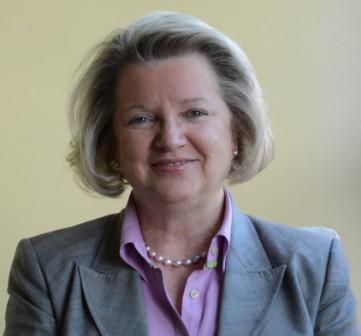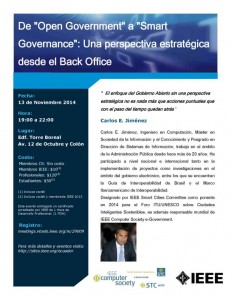The Physics and Mathematics of Mobile Wireless Communication Explained Through an Electromagnetic Macro Model
Tapan Sarkar y Magdalena Salazar-Palma
Guayaquil, Lunes 1 de Junio 2015, 9.30 am
Auditorio de la Facultad de Ingeniería en Electricidad y Computación, Escuela Superior Politécnica del Litoral.
Quito, Martes 2 de Junio 2015, 9.00 am
Auditorio de la Facultad de Ingeniería Eléctrica y Electrónica, Escuela Politécnica Nacional.
The objective of this talk is to illustrate the physics associated with the propagation of mobile wireless communication signals. It is shown that an electromagnetic macro model can predict the nature of the path loss exponent in a mobile cellular wireless communication without the use of a statistical model which is devoid of basic physics. Hence this talk makes it possible to analyze propagation of wireless signals in any environment without introducing an adhoc reference distance in the model. Invariably, the reference distance chosen for the model is incorrect as the cell is located in the near field as opposed to be in the far field. In addition, the use of a two ray model provides a path loss exponent of 4 and not 3 which is the actual value within a cell as first described by Okumura in his classic paper. Specifically, we illustrate that the path loss exponent in a cellular wireless communication is three preceded by a slow fading region and followed by the fringe region where the path loss exponent is four. The size of these regions is determined on the heights of the base station transmitting antennas and the receiving antennas. These principles are illustrated by using the analysis of radiation from a vertical electric dipole situated over a horizontal imperfect ground plane which was first presented by Sommerfeld in 1909. When the Sommerfeld integrals are evaluated using a modified saddle point method for field points moderate to far distances away from the source point, through moderate to large values of the numerical distance, the correct path loss exponents can be obtained. Okumura’s experimental data are analyzed using the Sommerfeld formulation. In addition, the physics of the radio wave propagation in a cellular wireless system will be discussed.
Acerca de los Expositores
 Tapan K. Sarkar received the B.Tech. degree from the Indian Institute of Technology, Kharagpur, in 1969, the M.Sc.E. degree from the University of New Brunswick, Fredericton, NB, Canada, in 1971, and the M.S. and Ph.D. degrees from Syracuse University, Syracuse, NY, in 1975. From 1975 to 1976, he was with the TACO Division of the General Instruments Corporation. He was with the Rochester Institute of Technology, Rochester, NY, from 1976 to 1985. He was a Research Fellow at the Gordon McKay Laboratory, Harvard University, Cambridge, MA, from 1977 to 1978. He is now a Professor in the Department of Electrical and Computer Engineering, Syracuse University. His current research interests deal with numerical solutions of operator equations arising in electromagnetics and signal processing with application to system design. He has authored or coauthored more than 300 journal articles and numerous conference papers and 32 chapters in books and fifteen books.
Tapan K. Sarkar received the B.Tech. degree from the Indian Institute of Technology, Kharagpur, in 1969, the M.Sc.E. degree from the University of New Brunswick, Fredericton, NB, Canada, in 1971, and the M.S. and Ph.D. degrees from Syracuse University, Syracuse, NY, in 1975. From 1975 to 1976, he was with the TACO Division of the General Instruments Corporation. He was with the Rochester Institute of Technology, Rochester, NY, from 1976 to 1985. He was a Research Fellow at the Gordon McKay Laboratory, Harvard University, Cambridge, MA, from 1977 to 1978. He is now a Professor in the Department of Electrical and Computer Engineering, Syracuse University. His current research interests deal with numerical solutions of operator equations arising in electromagnetics and signal processing with application to system design. He has authored or coauthored more than 300 journal articles and numerous conference papers and 32 chapters in books and fifteen books.
Dr. Sarkar is a Registered Professional Engineer in the State of New York. He received the College of Engineering Research Award in 1996 and the Chancellor’s Citation for Excellence in Research in 1998 at Syracuse University. He is a member of Sigma Xi and International Union of Radio Science Commissions A and B. He was the 2014 President of the IEEE Antennas and Propagation Society. According to Google Scholar, he has a H-index of 60 with 15,009 citations to his work.
He is also the president of OHRN Enterprises, Inc., a small business incorporated in New York state (1985) performing various research work for various organizations in system analysis.
He received Docteur Honoris Causa from Universite Blaise Pascal, Clermont Ferrand, France in 1998, from Politechnic University of Madrid, Madrid, Spain in 2004, and from Aalto University, Helsinki, Finland in 2012. He received the medal of the friend of the city of Clermont Ferrand , France, in 2000.
 Magdalena Salazar-Palma was born in Granada, Spain. She received the MS and PhD degrees in Electrical and Electronic Engineering from Polytechnic University of Madrid, Spain, where she was Assistant and Associate Professor at the Department of Signals, Systems and Radiocommunications. Since 2004 she is with the Department of Signal Theory and Communications, Charles the Third University of Madrid, Spain, where she is Full Professor, co-director of the Radiofrequency, Electromagnetics, Microwaves and Antennas Research Group (GREMA) and has served for three years as Department head.
Magdalena Salazar-Palma was born in Granada, Spain. She received the MS and PhD degrees in Electrical and Electronic Engineering from Polytechnic University of Madrid, Spain, where she was Assistant and Associate Professor at the Department of Signals, Systems and Radiocommunications. Since 2004 she is with the Department of Signal Theory and Communications, Charles the Third University of Madrid, Spain, where she is Full Professor, co-director of the Radiofrequency, Electromagnetics, Microwaves and Antennas Research Group (GREMA) and has served for three years as Department head.
She has authored or co-authored 673 scientific publications: 7 scientific books and 25 contributions for books published by international editorial companies, 13 contributions for academic books, 101 papers in scientific journals, 356 papers in international conferences, symposia, and workshops, 76 papers in national conferences, 53 project reports, 30 short courses notes, and 9 other publications. She has coauthored 2 European/USA patents and several software packages for the analysis and design of microwave and millimeter wave passive components, antennas and antenna arrays, advanced filters and multiplexers, which are under exploitation by multinational companies.
In 2009 she was elected as 2010 AP-S President-Elect, serving in 2011 as AP-S President and member of the Technical Activities Board (TAB), and, in 2012, as AP-S Past President, Chair of AP-S Nominations Committee and Chair of AP-S Past Presidents Council. She has been the General Chair of MGAB Sections Congress 2014.
Costos y Registro
Miembros y Estudiantes IEEE: Sin Costo*
Profesionales $55**
Estudiantes $20**
*No incluye certificado. Costo de $5,00 por emisión de certificados.
**Incluye certificado, membresía IEEE y APS hasta Feb 2016. No aplica para renovaciones.

